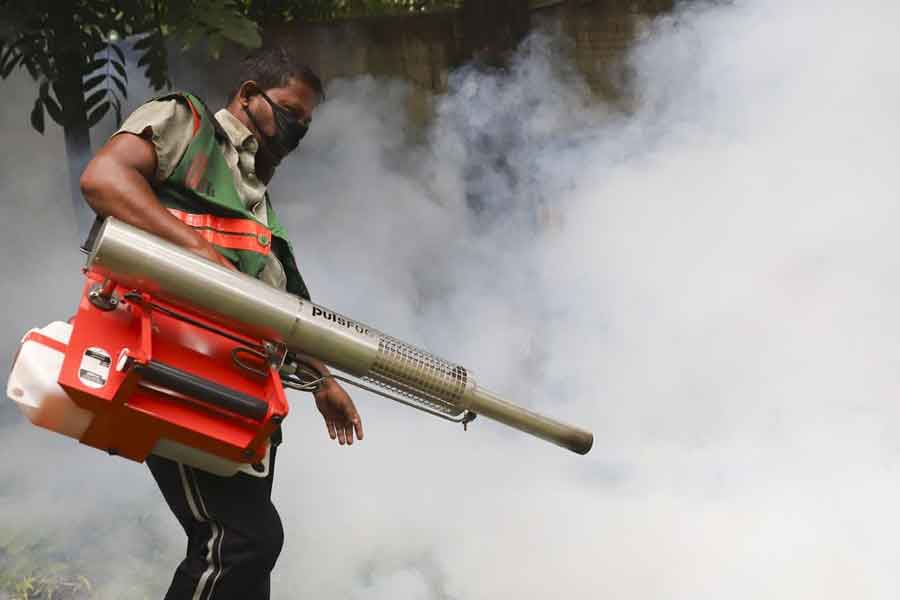
Published :
Updated :

Morning fog is quite natural but certainly not at this time of the rainy season. But recently the residents of Dhaka North City Corporation (DNCC) have been experiencing fog that envelops roads and alleys for a while. This fog is, however, not natural and moist. It is the fumes that are released from fogging machines. Yes, the administrator of the DNCC perhaps wanted to show his administration is different from the mayors under whose reigns, fogging was done in the late afternoon or evening. No explanation was given for this shift in fogging from evening to morning.
Imagine the thick fog-like fumes are all over the street school kids and their parents have to negotiate on their way to educational institution. Even commuters who get out for office also discover themselves in the morning fogging frenzy. It is not confined to this uneasy feeling and irritation on street, the nasty odour invades indoors. If the fumes are wafted into people's homes right at the moment when the family is at the breakfast table, the feeling of nausea produced is unavoidable. Some sensitive mortals may feel vomiting and if a few end up surrendering to the feeling, they cannot be blamed.
It is because the fumes are extremely repellent to human nostrils. Strangely, no expert has concluded that those have any effect on Aedes aegypti, the female of which variety is the vector of dengue. Only culex subspecies which lays its eggs in polluted waters of drain may be victim to such fogging. Both anopheles and aedes choose clean and stagnant water for laying their eggs.
Currently, the country is facing a challenge for arresting the spread of dengue and chikungunia not malaria or Japanese encephalitis or West Nile virus. Well, the cases of malaria spread by anopheles are rare now and Japanese encephalitis and Nile virus spread by culex are an unheard of phenomenon here. Evidently, the fogging is a wasteful exercise. The last mayor made a candid admission of this futile exercise.
Clearly, fogging is a misplaced drive against aedes. The waste of public money on such programmes is nothing but fooling the inhabitants of the city. Kolkata has developed a round-the-year monitoring and follow-up crash programme involving volunteers and residents alongside its city corporation officials and employees. This is exactly what Dhaka needs to destroy the breeding places of aedes mosquitoes. The moment one or two patients are located from an area, the entire vicinity has to be barricaded for launching drives to eliminate any source of potential breeding spot.
Fogging has proved useless and it will fail to contain aedes particularly in this rainy season when rains are falling without notice. Formation of local brigades ought to be the first priority and on the basis of their active participation the city corporation officials and employees will visit every house to inspect if it has any place on ground or rooftop where rain waters may accumulate allowing aedes to breed and proliferate.
There are also open spaces in between two rows of residential accommodations where broken pots, rejected plastic dish, coconut shells etc gather rains providing ideal breeding grounds for anopheles and aedes. A list of such places has to be made for removal and regular application of larvicides ensured. Biological insecticide like bacillus thuringiensis israelensis (Bti) and spinosad, an insecticide derived from soil bacterium are highly effective in destroying the larvae. Also methoprene and pyroproxyfen can control larvae growth. If the spots are precisely detected, any of these larvicides or insecticides can be regularly applied there to systematically destroy the vectors of dengue.
The interim government's effort to rein in waste of public money cannot be successful if it fails to gain full knowledge of how the money goes down the drain. The case of drive against aedes is clear enough for it to intervene not only in the interest of saving public fund but also to focus on an effective campaign aimed at avoiding a dengue epidemic.
nilratanhalder2000@yahoo.com


 For all latest news, follow The Financial Express Google News channel.
For all latest news, follow The Financial Express Google News channel.